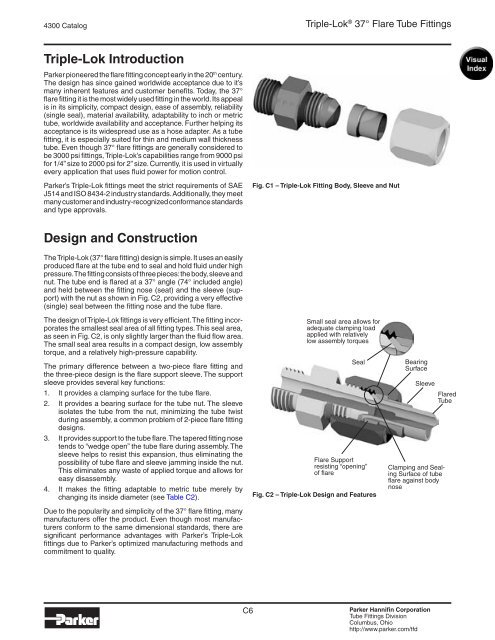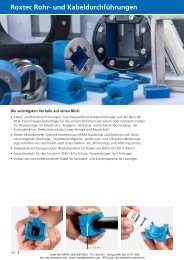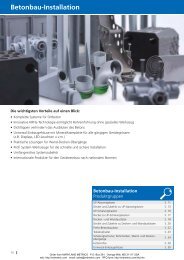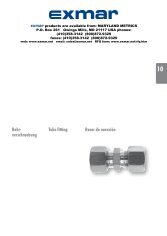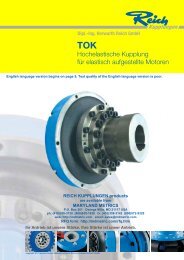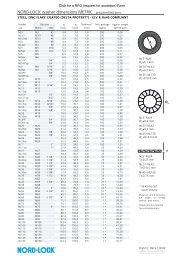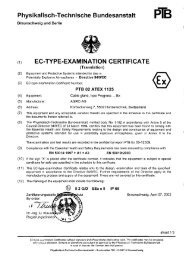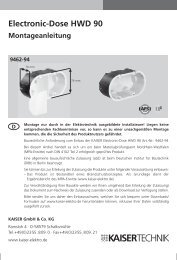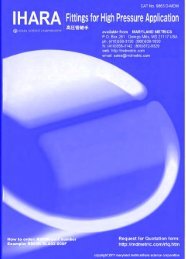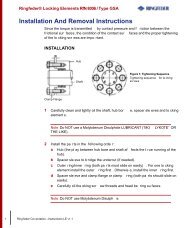Triple-Lok® and Triple-Lok® 2 37° Flare Tube Fittings
Triple-Lok® and Triple-Lok® 2 37° Flare Tube Fittings
Triple-Lok® and Triple-Lok® 2 37° Flare Tube Fittings
You also want an ePaper? Increase the reach of your titles
YUMPU automatically turns print PDFs into web optimized ePapers that Google loves.
4300 Catalog<br />
<strong>Triple</strong>-Lok Introduction<br />
Parker pioneered the flare fitting concept early in the 20 th century.<br />
The design has since gained worldwide acceptance due to it’s<br />
many inherent features <strong>and</strong> customer benefits. Today, the <strong>37°</strong><br />
flare fitting it is the most widely used fitting in the world. Its appeal<br />
is in its simplicity, compact design, ease of assembly, reliability<br />
(single seal), material availability, adaptability to inch or metric<br />
tube, worldwide availability <strong>and</strong> acceptance. Further helping its<br />
acceptance is its widespread use as a hose adapter. As a tube<br />
fitting, it is especially suited for thin <strong>and</strong> medium wall thickness<br />
tube. Even though <strong>37°</strong> flare fittings are generally considered to<br />
be 3000 psi fittings, <strong>Triple</strong>-Lok’s capabilities range from 9000 psi<br />
for 1/4” size to 2000 psi for 2” size. Currently, it is used in virtually<br />
every application that uses fluid power for motion control.<br />
Parker’s <strong>Triple</strong>-Lok fittings meet the strict requirements of SAE<br />
J514 <strong>and</strong> ISO 8434-2 industry st<strong>and</strong>ards. Additionally, they meet<br />
many customer <strong>and</strong> industry-recognized conformance st<strong>and</strong>ards<br />
<strong>and</strong> type approvals.<br />
Design <strong>and</strong> Construction<br />
The <strong>Triple</strong>-Lok (<strong>37°</strong> flare fitting) design is simple. It uses an easily<br />
produced flare at the tube end to seal <strong>and</strong> hold fluid under high<br />
pressure. The fitting consists of three pieces: the body, sleeve <strong>and</strong><br />
nut. The tube end is flared at a <strong>37°</strong> angle (74° included angle)<br />
<strong>and</strong> held between the fitting nose (seat) <strong>and</strong> the sleeve (support)<br />
with the nut as shown in Fig. C2, providing a very effective<br />
(single) seal between the fitting nose <strong>and</strong> the tube flare.<br />
The design of <strong>Triple</strong>-Lok fittings is very efficient. The fitting incorporates<br />
the smallest seal area of all fitting types. This seal area,<br />
as seen in Fig. C2, is only slightly larger than the fluid flow area.<br />
The small seal area results in a compact design, low assembly<br />
torque, <strong>and</strong> a relatively high-pressure capability.<br />
The primary difference between a two-piece flare fitting <strong>and</strong><br />
the three-piece design is the flare support sleeve. The support<br />
sleeve provides several key functions:<br />
1. It provides a clamping surface for the tube flare.<br />
2. It provides a bearing surface for the tube nut. The sleeve<br />
isolates the tube from the nut, minimizing the tube twist<br />
during assembly, a common problem of 2-piece flare fitting<br />
designs.<br />
3. It provides support to the tube flare. The tapered fitting nose<br />
tends to “wedge open” the tube flare during assembly. The<br />
sleeve helps to resist this expansion, thus eliminating the<br />
possibility of tube flare <strong>and</strong> sleeve jamming inside the nut.<br />
This eliminates any waste of applied torque <strong>and</strong> allows for<br />
easy disassembly.<br />
4. It makes the fitting adaptable to metric tube merely by<br />
changing its inside diameter (see Table C2).<br />
Due to the popularity <strong>and</strong> simplicity of the <strong>37°</strong> flare fitting, many<br />
manufacturers offer the product. Even though most manufacturers<br />
conform to the same dimensional st<strong>and</strong>ards, there are<br />
significant performance advantages with Parker’s <strong>Triple</strong>-Lok<br />
fittings due to Parker’s optimized manufacturing methods <strong>and</strong><br />
commitment to quality.<br />
C6<br />
<strong>Triple</strong>-Lok ® <strong>37°</strong> <strong>Flare</strong> <strong>Tube</strong> <strong>Fittings</strong><br />
Fig. C1 – <strong>Triple</strong>-Lok Fitting Body, Sleeve <strong>and</strong> Nut<br />
Small seal area allows for<br />
adequate clamping load<br />
applied with relatively<br />
low assembly torques<br />
Seal<br />
<strong>Flare</strong> Support<br />
resisting “opening”<br />
of flare<br />
Fig. C2 – <strong>Triple</strong>-Lok Design <strong>and</strong> Features<br />
Bearing<br />
Surface<br />
Parker Hannifin Corporation<br />
<strong>Tube</strong> <strong>Fittings</strong> Division<br />
Columbus, Ohio<br />
http://www.parker.com/tfd<br />
Sleeve<br />
<strong>Flare</strong>d<br />
<strong>Tube</strong><br />
Clamping <strong>and</strong> Sealing<br />
Surface of tube<br />
flare against body<br />
nose


